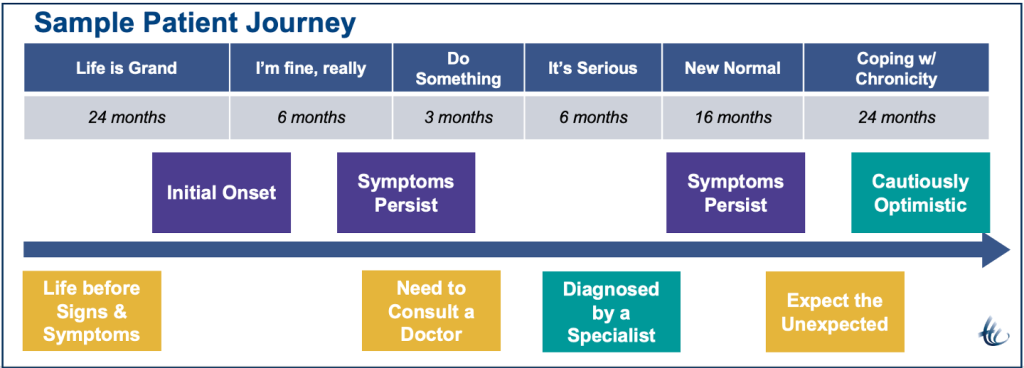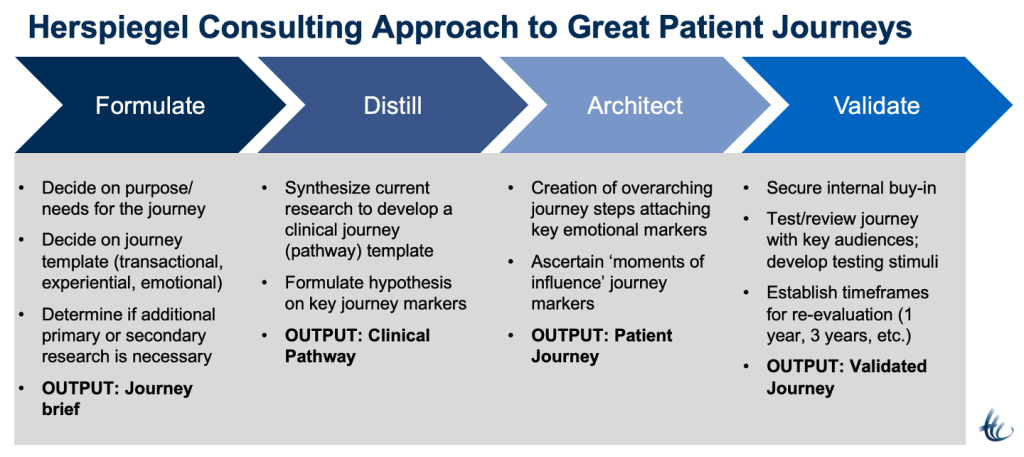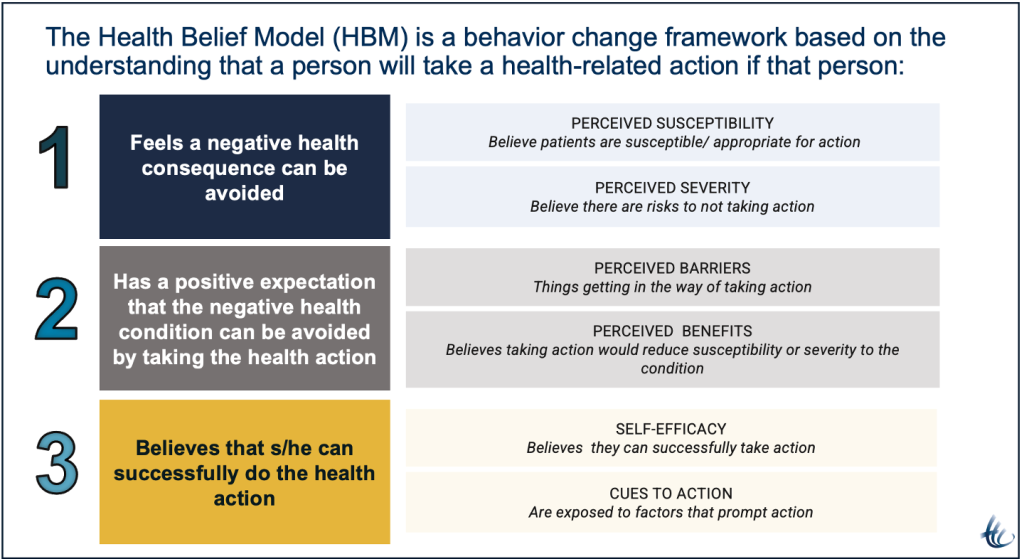Components of a pharma and biotech go-to-market strategy
Getting FDA approval for a product is only one part of the battle for pharma and biotech companies. There are many next steps for drugmakers to consider to navigate the launch of a new drug or treatment, whether it’s a new-to-market product or an existing asset that’s gained an additional indication. To successfully bring a product to market multiple factors need to be mapped out carefully by the launch team.
At Herspiegel we have partnered with biotech and pharma companies big and small and have successfully brought millions of dollars worth of drugs, devices, and treatments to market. But before we get a product out the door, we help launch teams navigate their go-to-market strategies. There are four components to each of our product launch strategies:
- Where to play
- How to win
- How to execute
- The launch plan
Bringing a product to the launch stage is a critical moment in a product’s lifecycle. After that, the first six months are crucial for the drug’s trajectory. With healthcare costs increasing, patients and providers are more aware of product differentiation, especially when there isn’t any. So first thing is first. Every launch strategy needs to start with knowing ‘where to play.’
Effective communication starting even before launch into the marketplace is very important for the product to get a good start. The value proposition at launch has to be crystal clear to customers: patients, providers, and payers alike. This is our ‘how to win’ component of the product launch strategy.
The general belief is that to succeed in any launch, you must get in early. But being first doesn’t necessarily mean success, products also have to find ways to differentiate themselves from competitors and require clinical trials, market research, and better product development to get ahead in the marketplace. Drug launches suffer when the product’s proposition doesn’t provide enough added value to the treatment landscape. More specifically, how will this product stand up to today’s standard of care and will it still be relevant two years from now? Well-defined execution and launch plans are key to driving overall launch success.
Part 1: Where to Play?
There are four main elements to how we help our clients discover ‘where to play’:
- Market assessment
- Customer journey
- Market map
- Customer segmentation
1. Market Assessment
The first step before going to market with a new product is to answer several key business questions that will help define the current addressable market and what it might look like 36 months from now:
- What is the disease diagnosis and treatment paradigm?
- Who is the ideal patient and what are the unmet needs?
- Who are the anticipated prescribers? What are their current attitudes and behaviors?
- What is the patient journey for assumptive targets?
- What are the critical influence points within the patient journey?
- How do we gain market access from payers?
- What is the anticipated competitive situation?
- How will assets in development shape the market?
Various forces are changing the environment in which pharma operates and the relative positions of the different players in the healthcare arena. Opportunity assessments should also include being aware of the business environment that the treatment or drug will play in before adding a new product to the mix, which includes evaluating factors such as:
- Technological developments
- Government regulations
- Geopolitical shifts
- Economic indicators
- Trade policies
- Social and cultural norms
- Environmental considerations
Good product differentiation includes introducing features that are first of its kind within its market. These are drug properties that are valuable and not part of your competitor’s drug. To know this, you need to obtain a broader understanding of the market as a whole, and what the potential of success is in the market. Many companies are researching the same diseases and end up battling for the market as early as the research phase. It’s also important to explore adjacent markets and opportunities.
Analyzing the landscape at multiple levels will help you evaluate the demand for a treatment or drug, and whether expanding into a potential new market is worthwhile for your company. Product innovation is costly and involves high levels of risk and long lead times. The number of treatment options, the size and number of established incumbents, and the differentiation in clinical outcomes among them can also influence how much competition drives formulary positioning for your product. For example, there are more drug classes available to treat metabolic diseases such as diabetes and cardiometabolic disease than for certain cancer types. Among those drug classes, there is greater variability in patient response to cancer than in metabolic.
Understanding competition is imperative, especially during the drug development process but also being aware of ever-changing trends in the pharma marketplace is important for companies as they work to understand new business models and opportunities. The world has changed in the last couple of years and before going to market with a new product those changes need to be incorporated into the strategy starting with drug development.
2. Customer Journey
As part of go-to-market planning, manufacturers need to consider mapping and understanding the customer journey. The better they understand the patient journey, the more they have the ability to create a positive patient experience, leading to improved adoption and treatment adherence rates.

The Patient Journey uncovers all the touch-points that patients undergo in finding new treatments. In a patient journey, the customers (i.e.: physician/pharmacist/patients) are important stakeholders to consider in the analysis, to understand which are their needs, constraints, treatment and approaches. Finding out what they want is a vital element for marketing. This assessment will help the launch team define and uncover patient/HCPs pain points and determine if the drug or treatment will solve the right challenges. Finally, it will also assist in the development of the appropriate audience segmentation and engagement channels.
From a commercial perspective, understanding and using the patient voice in an organization offers competitive advantages when it comes to brand perception.

When written from the patient’s perspective (not the brand team’s), well constructed Patient Journeys begin prior to the initial onset of signs and symptoms and extend beyond the customer’s trial of the drug or treatment. It’s critical to acknowledge that the patient’s goal is remission, not just finding or using another NRx!
Patients have a stronger voice and are becoming better informed. Through focus groups and co-creation sessions with actual patients, companies can attain a more thorough understanding of patient care priorities and opportunities for ongoing communication improving the overall patient experience and also enabling their marketing teams to infuse the patient’s voice throughout the journey.
Firsthand insights combined with actionable marketing opportunities produce the “Moments of Meaning” which become the underpinnings of strategic and tactical plans. Moments of meaning represent the points in the patient journey when a brand can best engage a patient and advance their path towards better care.
3. Market Belief Map
The Health Belief Model (HBM) assumes that marketing/ product messages will achieve optimal behavior change if they successfully target perceived susceptibility, severity, barriers, benefits, self-efficacy, and cues to action. This model is useful for predicting the impact of an individual’s perception and attitude toward a disease and how those perceptions and attitudes will impact their health-related decision-making.

When companies are assessing ‘where to play’ the belief map can help pharma companies speak to what HCP’s and patients might be thinking throughout the standard treatment journey. What do they believe at each step of the process? Does that align with what the company wants them to believe? Are the beliefs misaligned?
4. Customer Segmentation
It is important to get your launch components right from the start because there is no time to recover from a slow or sluggish beginning.
In 2022, drug companies will need to be creative in crafting their value proposition and marketing claims. Differentiation drives value. If the treatment only has moderate or no differentiation, it will need to find a positioning edge to make it stand out from the crowd. Launch teams need to gain insights into prescriber behavior, payer needs, competitive dynamics, and patient profiles and use that data to craft their launch plan to each customer’s characteristics.
In order to understand patient behaviors and experiences, these are the questions that need to be answered in order to develop the right HCP segmentation for your go to market strategy:
- Which patients have the highest need for your therapy?
- Which doctors are most likely to prescribe your treatment?
- How can you mitigate risks of adherence issues?
- Which communications channels will be most effective?
Pharma companies will only be able to create value for their customers and effectively communicate that value if they have a real understanding of their customer needs. Not all customers want the same things. So what do they want and what will they be prepared to pay to get it? In general, consumers want what is best suited to their condition and lifestyle. Providers want cost-effective, practical tools to improve outcomes with their treatments. Pharma companies need to understand what will engage each group and communicate that effectively, understanding that priorities can vary further within customer categories. Segmentation not only helps with impactful messaging to the right audience but also serves as a basis for managing marketing resources and spend.
Summary
The pharma industry as well as the patient experience have evolved in many ways over the last couple of years. Because of this evolution, well-prepared launch plans were completely upended because of constantly shifting hurdles as well as opportunities. Agility has become a key ingredient to the more complex launch landscape as the healthcare environment has become much more dynamic and diverse.
Defining ‘where to play’ is the first step in developing an effective go-to-market strategy for your next product launch. In our second of four posts we will discuss additional elements for a successful go to market strategy. Up next, ‘How to Win: A deeper dive into brand positioning and opportunity analysis’.


